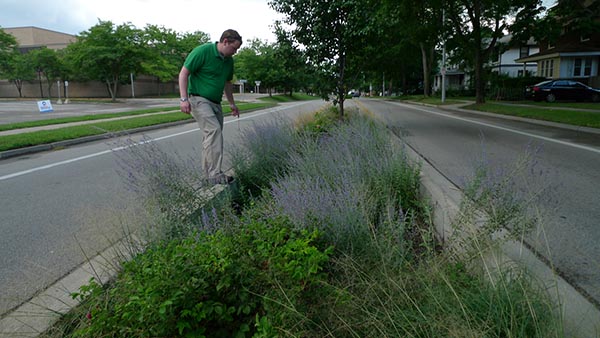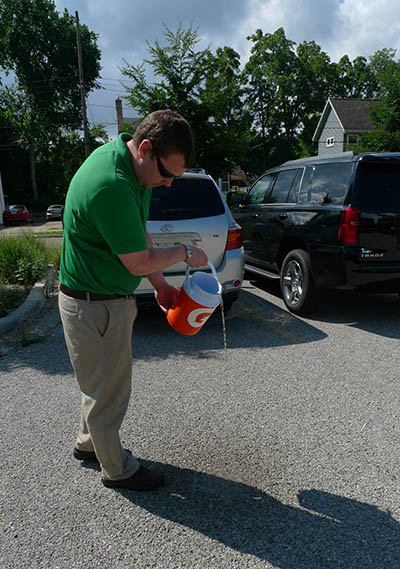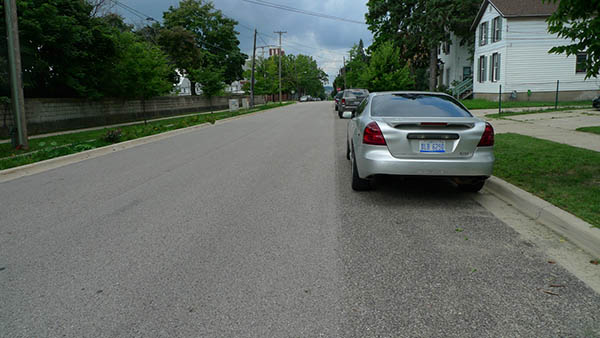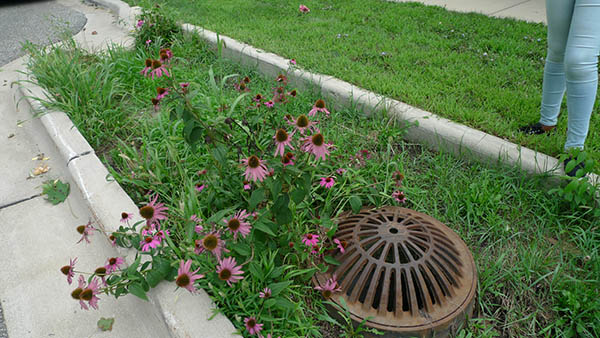How Grand Rapids is prepping for the next big storm

Getting rid of water that fell during a thunderstorm used to be a simple thing. The ground took its share, downspouts drained rooftops, and much of the rest found its way into gutters and storm sewers and on into the nearest body of water. The sun took care of the puddles.
That’s still the general idea, but things are more complicated today. A civil engineer, faced with a deluge from the sky, is likely to see opportunities, too – to relieve stress on sewer infrastructure, to keep it out of basements and other places where it’s unwelcome, to keep rivers and streams cleaner, even to enliven a boulevard with something other than yet another median strip covered with grass.
And there’s so much more rainwater these days, not overall, but all at once; the U.S. Environmental Protection Agency reports that “heavy precipitation” events,in which large amounts of rain or snow fall in a short period, are steadily increasing. Ask anyone in Louisiana, where near-apocalyptic rainfall in early August brought never-before-seen levels of flooding to Baton Rouge. Or ask the residents of Detroit, who were flooded by a 500-year storm in 2014 that dumped more than four inches of rain – over six inches in some areas – in 12 hours.
When that kind of rain comes down, every drop that can be diverted to a retention pond, infiltration basin or rain garden can keep a city’s sewer and stormwater system from being overwhelmed. And when that kind of rain isn’t coming down, these manmade structures keep pollutants, solid waste and other unwelcome substances out of a river or lake where a city draws its drinking water, swims or plays.
Related: Detroit banks on green infrastructure to rescue city from heavy rains
Around Michigan, municipalities are constructing so-called blue or green infrastructure, environmentally friendly installations to better manage resources and rainfall. The Detroit Future City initiative has a project to reduce runoff. Communities in northern Michigan are learning from a rain garden built in Suttons Bay, and a pavement that allows rainwater to soak through at a Meijer in Manistee. Grand Rapids and Ann Arbor, meanwhile, remain leaders in installing these features, as well as educating and encouraging the public to install their own.
Grand Rapids has separated its sanitary and storm sewers since 1991. (Combined sewers, in which stormwater and sewage run through the same pipes, can be problematic during heavy rains; when sewers fill to capacity, raw sewage can back up into basements or overflow into waterways.) Grand Rapids is nearly done with the job, said Mike Lunn, manager of the city’s Environmental Services Department. Once it was finished, he said, “An inch or two of rain didn’t change flows at the wastewater plant. We realized we didn’t have to put all that water into a pipe and run it into the river.”
So the city began work on various projects that would capture rainfall in wetlands and other, more natural settings and put it to better use.
First was an infiltration basin at Joe Taylor Memorial Park in Grand Rapids. Situated in the city’s Baxter neighborhood, it’s a modest, two-acre parcel whose major feature is a splash pad, beloved by neighborhood children on hot days. But it’s the park’s infrastructure that earned it a Frontline Parks award for excellence from the City Parks Alliance, a national advocacy group.
Unlike a retention pond, which holds water above ground, an infiltration basin like the one at Joe Taylor Park is installed underground, in this case beneath a parking lot with a porous concrete surface. The basin captures water and holds it until it can percolate down through gravel and sand and into the earth, keeping it out of sewers, refreshing water tables and cleaning it of pollutants in the bargain. The porous concrete looks like any other parking lot, perhaps a little rougher on the surface, but that surface absorbs water rather than allowing it to run off.
Lunn said porous concrete is generally not as strong as the conventional kind, so it’s reserved for parking lots and lanes, rather than pavement that carries vehicle traffic. It also needs to be vacuumed a couple times a year, so that sand and grit won’t clog the pores.
The basin under the park drains about 40 acres, and can hold 270,000 gallons of stormwater, the equivalent of the first inch of fast-falling rain.
There’s also a hydrodynamic separator nearby, a fairly new underground device that activates when storms hit, cleaning runoff before it gets into sewer lines. The separator spins, pulling solids – trash ranging from pop bottles to cigarette butts – out of the deluge and into a separate basin, where they’re removed by crews later.
“You wouldn’t believe how much we pull out of that,” said Michael Stall, civil engineer with the city. “That’s all stuff that would end up in the river if it wasn’t there.”
A statewide challenge
Even before lead-poisoning entered Flint’s water supply in 2014, Michigan wasn’t known for treating its water infrastructure with loving care. A 2009 report card from the American Society of Civil Engineers gave the state a D-plus in how it managed stormwater, noting for instance that there was no statewide inventory of its stormwater management systems. Not that most states were any better.
“Out of sight, out of mind,” said Ron Brenke, executive director of the Michigan section of the ASCE. “As long as the toilet flushes and the drinking water is clean, most people don’t care what sort of shape it’s in.”
Parts of the state’s urban sewer systems are so old that sections are made from wood, Brenke said, “but we really don’t know how much,” making it difficult for utilities and cities to accurately budget for maintaining or replacing underground pipes and basins. The state Department of Environmental Quality has a grant program to allow municipalities to develop management plans, but it requires local matching funds for all but the most economically distressed cities.
A report by Lansing-based Public Sector Consultants released in April estimated that $3 billion and likely more is needed to bring the state’s drinking water, stormwater and wastewater infrastructures up to acceptable standards (Disclosure: The Center for Michigan, of which Bridge is a part, is a PSC client). Gov. Rick Snyder has made this sector part of a comprehensive 21st Century Infrastructure Commission, formed in the wake of the Flint water crisis and charged with identifying a strategy to modernize the state’s transportation, communications, energy and water infrastructure over the next half-century.
Gardening in Ann Arbor
But leaders in Ann Arbor and surrounding Washtenaw County aren’t waiting for state solutions.
Residents “get the connection between the condition of the (Huron) River and the public’s drinking water,” said Jen Lawson, water quality manager for the city. Ann Arbor’s sewers have always been separate, so sewage overflow isn’t a problem. Ann Arbor works closely with Washtenaw County, Lawson said, to make environmentally friendly infrastructure improvements, and the map is studded with them, particularly residential rain gardens, which have been embraced by residents.
A rain garden sits on low-lying ground. During periods of low or normal rainfall, they look more like prairie-type swales than formal flower gardens. But in a deluge, they can collect thousands of gallons of runoff. Grand Rapids has three on the grounds of the city public-works building complex.
The River of Dreams Rain Garden, the second to be installed on Grand Rapids’ city-owned land, was drenched by a 4.7-inch rainfall one week after it was planted in 2008. Photos taken at the time show the garden looking like a pond; engineers estimate it took in 189,000 gallons in 73 minutes. But in two days, it had all been absorbed and all the plants survived.
In this dry year, the garden, and others like it, continue to thrive. In the otherwise dull landscape of the city’s public-works complex, a space dominated by cavernous garages and no-frills government buildings, the rain gardens are full of life, attracting bees, birds and butterflies to the milkweed, purple coneflowers and native prairie grasses growing there.
The city estimates it even saved money on the project, installing the garden for $35,000, where traditional drainage infrastructure such as underground pipes would have cost $60,000. And 1.5 million gallons of stormwater is kept out of the Grand River in the bargain, water that doesn’t have to be processed through the city’s treatment plant, either.
Climate change is generally acknowledged as one driver behind latter-day, how’s-that-ark-coming-along storms, Ann Arbor’s Lawson said. In 2014, the city adopted a “green streets” resolution, which makes stormwater defense a top priority during street construction projects. Under a green-streets model, the first inch of rainfall that would run off the impermeable surface of the road must be absorbed, if not by the road itself, then by nearby structures.
“Roads have 25 percent of the impervious area in town,” said Lawson. Add rooftops, parking lots and other hard surfaces, and around 40 percent of the city’s acreage sheds water rather than absorbing it.
Green streets attempt to reduce that runoff. A median strip, for instance, can easily be converted from a flat, grass-covered feature to a lower-lying rain garden. On Grand Rapids’ Plainfield Avenue, seven median islands between Page and Ann Streets can capture 90,000 gallons, enough to fill three backyard swimming pools.
Spreading the gospel
Property owners are encouraged to build their own features as well. Ann Arbor, in cooperation with Washtenaw County, runs a master rain gardener education program, and those who install rain gardens (or rain barrels) on private property can get a discount on the stormwater piece of their water bill, Larson said.
(The hazards of standing water aren’t a concern for these structures; they are designed to absorb even the heaviest rainfall within 72 hours, days shorter than the life cycle of a typical mosquito.)
Grand Rapids and Ann Arbor officials say the benefits and surging popularity of these structures are nudging more cities into trying such strategies. The Southeast Michigan Council of Governments publishes a manual for cities to adopt their own strategies, and the metro Detroit communities of Southfield, Sterling Heights and Auburn Hills are starting to experiment with them, said Amy Mangus, plan implementation manager for SEMCOG.
As late-summer storms rumble through the state, some dropping heavy amounts of rainfall, even small steps like rain gardens and bioswales (a similar feature with some technical differences) add up to significant improvement in overall water quality in a given watershed.
The Huron River is seeing more diverse and healthier fish and insect species, Lawson said, “caddisflies and stoneflies, in higher quantities.”
In Grand Rapids, where the city is working on improvements to its namesake feature to improve downtown, the quality of what flows through the Grand River is essential, said Staal, the civil engineer. “People are starting to get it,” Staal said. “It’s a quality-of-life issue for cities.”
See what new members are saying about why they donated to Bridge Michigan:
- “In order for this information to be accurate and unbiased it must be underwritten by its readers, not by special interests.” - Larry S.
- “Not many other media sources report on the topics Bridge does.” - Susan B.
- “Your journalism is outstanding and rare these days.” - Mark S.
If you want to ensure the future of nonpartisan, nonprofit Michigan journalism, please become a member today. You, too, will be asked why you donated and maybe we'll feature your quote next time!
 Grand Rapids’ Plainfield Avenue has median strips you step down into from the road bed. Rain from surrounding pavement flows into them and is held by the soil and water-loving plants and trees until it can be absorbed or evaporate. (Bridge photo by Nancy Derringer)
Grand Rapids’ Plainfield Avenue has median strips you step down into from the road bed. Rain from surrounding pavement flows into them and is held by the soil and water-loving plants and trees until it can be absorbed or evaporate. (Bridge photo by Nancy Derringer) Michael Staal, civil engineer for the city of Grand Rapids, demonstrates the porous pavement at Joe Taylor Memorial Park. The cooler full of water he poured out didn’t run to a gutter or puddle; rather, it seeped through the surface of the lot and into an underground infiltration basin, where it will eventually go back into the soil. (Bridge photo by Nancy Derringer)
Michael Staal, civil engineer for the city of Grand Rapids, demonstrates the porous pavement at Joe Taylor Memorial Park. The cooler full of water he poured out didn’t run to a gutter or puddle; rather, it seeped through the surface of the lot and into an underground infiltration basin, where it will eventually go back into the soil. (Bridge photo by Nancy Derringer) The slightly darker strip of pavement in the parking lane indicates where the porous surface begins. Because porous concrete is weaker than the conventional kind, it’s reserved for parking areas, which get less wear and tear than driving lanes. (Bridge photo by Nancy Derringer)
The slightly darker strip of pavement in the parking lane indicates where the porous surface begins. Because porous concrete is weaker than the conventional kind, it’s reserved for parking areas, which get less wear and tear than driving lanes. (Bridge photo by Nancy Derringer) A bump-out rain garden takes in water running downhill from the curb cut at top left and diverts it into a low-lying garden that runs parallel to the curb. The metal structure is an outlet drain, should the garden get overfilled. (Bridge photo by Nancy Derringer)
A bump-out rain garden takes in water running downhill from the curb cut at top left and diverts it into a low-lying garden that runs parallel to the curb. The metal structure is an outlet drain, should the garden get overfilled. (Bridge photo by Nancy Derringer)